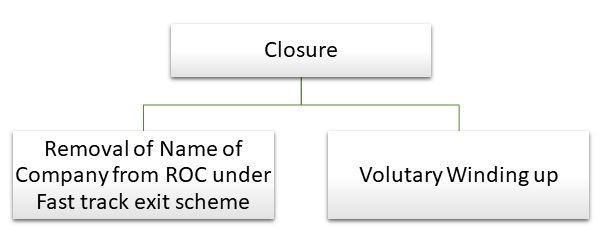How To Close A Private Limited Company?
FAST TRACK EXIT Under Section 248 Of The Companies Act, 2013
A Private limited company is tied with many regulations and compliances, if you do not carry on any business and the company is just sitting there, withstanding the test of time, the company is infact accumulating all the non-compliances which has to be complied with if you wish to close the company in the future.
What are the ways of closing a Private limited company?

This article contains provisions relating to closure of a private limited company under fast track exit route. Closure under this route is governed by the provisions of Section 248 of the Companies Act, 2013 read with Rule 4 of The Companies (Removal of Name of companies from the Registrar of Companies) Rules, 2016.
Removing the name of the company from the registrar of companies under Fast track exit mode.
- The following companies can be closed through this route,
- a defunct company, which is a company that has NIL assets and liabilities and failed to commence business within one year of incorporation.
- A dormant company which is a company that is not carrying on any business or operation for a period of two immediately preceding financial years or has not filed financial statements and annual returns during the last two financial years
- A company whose subscribers have not paid the subscription amount and a declaration to this effect has not been filed within 180 days of its incorporation. (subscription amount is nothing but the consideration against which equity shares have been allotted.)
- For closure of the company under this route, the company has to make an application to the registrar in Form STK-2.
- It has to be noted that, closure of a company under this route is much easier and takes much less time if the company has complied with all the statutory regulations.
What do you mean by “a company which has complied with all the statutory regulations”?
Following conditions should be satisfied for filing Form STK-2,
- The company must have filed Form AOC-4/AOC-4 XBRL and Form MGT-7 upto the end of the financial year in which the company ceased to carry on its business operations.
- The company should have filed INC – 20A.
- DIR – 3 KYC in respect of all the directors should have been filed.
Note: Even though filing of Form INC 20A and DIR 3- KYC is not mandatory for filing Form STK-2 as per Rule 4 of The Companies (Removal of Name of companies from the Registrar of Companies) Rules, 2016. In a practical scenario, e form STK -2 cannot be filed without filing INC -20A and DIR- 3 KYC.
What do you need to file e Form STK-2?
- Indemnity bond duly notarized by every director in Form STK 3.
- A statement of accounts containing assets and liabilities of the company made up to a day, not more than thirty days before the date of application and certified by a Chartered Accountant.
- An affidavit in Form STK 4 by every director of the company.
- a copy of the special resolution duly certified by each of the directors of the company or consent of seventy-five per cent of the members of the company in terms of paid up share capital as on the date of application.
- A statement regarding pending litigations, if any, involving the company.
Companies which cannot file Form STK-2
- Section 8 (NOT FOR PROFIT) company
- Any company, which at any time in the previous 3 months,
- has changed its name or shifted its registered office from one State to another
- has made a disposal for value of property or rights held by it, immediately before cessation of trade or otherwise carrying on of business, for the purpose of disposal for gain in the normal course of trading or otherwise carrying on of business.
- has engaged in any other activity except the one which is necessary or expedient for the purpose of making an application under that section, or deciding whether to do so or concluding the affairs of the company, or complying with any statutory requirement;
- has made an application to the Tribunal for the sanctioning of a compromise or arrangement and the matter has not been finally concluded
- is being wound up under Chapter XX of this Act or under the Insolvency and Bankruptcy Code, 2016
Some important FAQ’s relating to fast track exit route
- Can a company against which litigations are pending apply for closure under this scheme?
- Section 248 does not mention anywhere that a company against which litigations are pending should not apply for closure under this scheme.
- In light of the above, yes, a company against which litigations are pending can apply for closure under this route, but a statement containing the details of litigations should be attached to E-Form STK-2 while submission.
- Can a Company pending income tax/ sales tax/ central excise/ other Govt dues apply for closure under the Fast track exit route?
- No, such a company cannot apply for closure under this route.
- What is the effective date of closure under this route?
- The applicant company shall stand dissolved from the date the ROC publishes the list of companies struck off in the official gazette.
- What is the fees for filing e Form STK- 2?
- The fees is Rs. 10,000 which has to be paid at the time of submitting the form.